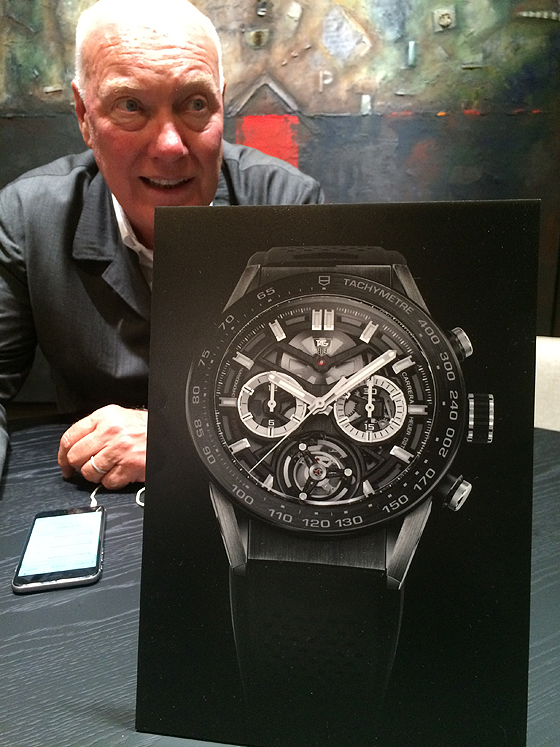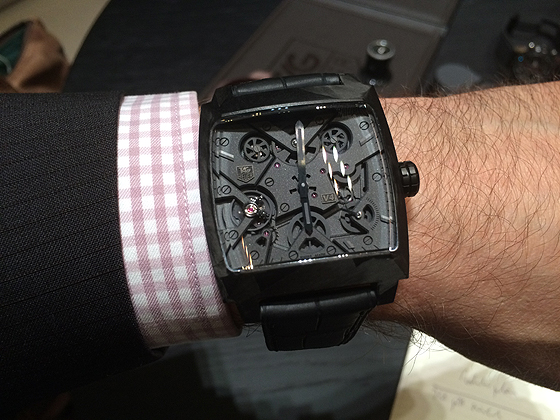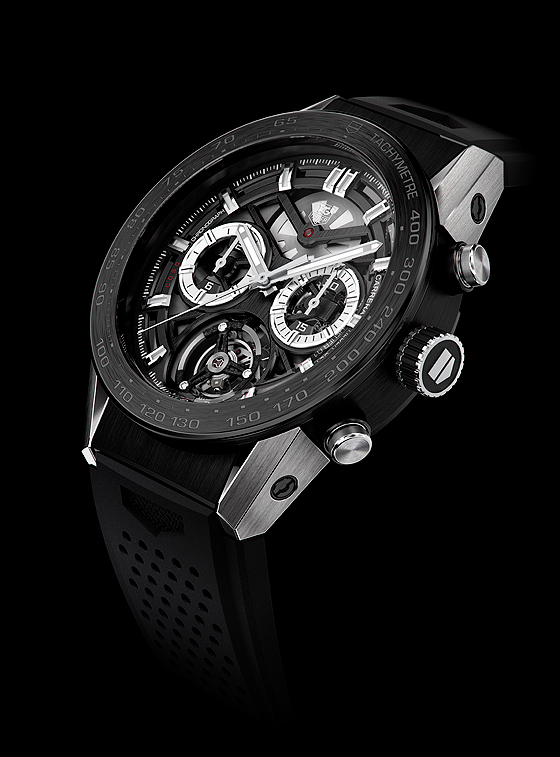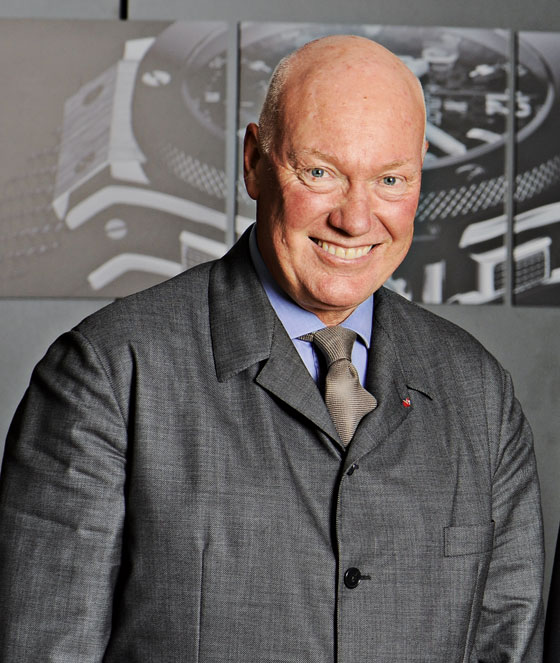Jean-Claude Biver has been quick to action as the new CEO at TAG Heuer – restructuring the brand, introducing new Carrera models, announcing an exceptionally economical tourbillon cheap Cartier replica watches, and soon, the brand’s own smartwatch. Learn more in this exclusive interview conducted at Baselworld by Rüdiger Bucher, Chronos.
RB: Mr. Biver, what is your strategy for TAG Heuer?
JCB: The strategy remains the same. Only a certain amount of creativity and development has been shifted from the upper segment to our core business area. We’re making a shift by redistributing our forces.
RB: Where does TAG Heuer have its core business?
JCB: In the price range between 2,000 and 5,000 Swiss francs. We’ve invested the most in this price range. Let me show you something. (He shows me the new Carrera Calibre Heuer 01.)
RB: Will this be the new look for the Carrera?
JCB: Yes. This is the look of the future. All the Carreras will eventually look like this. And this chronograph comes with our new movement.
RB: That would be the 1887?
JCB: The 1887, re-dimensioned and re-crafted. We call it the Heuer 01 now. We’re offering this new chronograph for 4,900 francs, which is a very competitive price. And very soon after that we will introduce a chronograph with a tourbillon for only 14,900 francs.
RB: How is it possible to offer a tourbillon at that price?
JCB: By producing everything ourselves and not buying expensive components like so many others do. We’ve reorganized entire production cells and made them profitable.
RB: So what are other manufacturers doing wrong?
JCB: Nothing. But TAG Heuer cannot demand the same prices as some other manufacturers. An Audi cannot cost the same as a Bentley. A Maserati doesn’t cost as much as a Ferrari even though both have a V-12 engine and both were designed by Pininfarina. Each brand has its price. We’ll sell a relatively large number of the new tourbillon model – maybe 500 or 1,000 pieces. There are lots of people with a budget of around 15,000 francs who’ll buy themselves a tourbillon. For us that’s much more beneficial than a highly complicated chronograph with 1/1,000-second precision, when we might only be able to produce 10 pieces of a watch like that each year.
RB: How are you able to produce the chronograph movement so economically? The numbers of the 1887 are not that high – around 50,000.
JCB: If you have the infrastructure for 20,000 movements and work diligently, maybe you can produce 30,000 at a good price. But if you’ve got the means for 50,000 and only make 30,000, prices will explode. When I came to TAG Heuer, many people suspected that prices would fall under my leadership, along with the prestige of the brand. But instead, we are introducing watches now like the Carrera Heuer 01 and the tourbillon at these competitive prices. And that makes us virtually unrivaled. And why? Because we have adjusted our structures. I’ve had to let some people go, but that isn’t my fault. I inherited the situation. And, because of these measures, the people who remain have more opportunities, and we can sell these Swiss Breitling replica watches sale at more attractive prices.
RB: In which areas did you let people go?
JCB: We had too many supervisory bodies, some of which were redundant. Too many hierarchies. We were simply overstructured. We wanted to make everything more perfect than perfect. This resulted in a lot of indirect costs that we were able to dispose of. And we used Hublot as our model.
RB: Was your infrastructure designed to make too many movements?
JCB: Not only that. TAG Heuer was not sufficiently pragmatic overall. The channels of communication had to be simplified. People who work next door to one another don’t have to communicate via computer or telephone. Some things are simply discussed faster and better at the coffee machine than with an internal e-mail.
RB: Is it possible to switch that around so quickly?
JCB: Yes, I was able to do it by separating myself from many people in leadership positions: new CEO; new sales director; new head of marketing; new head of service; new production managers for movements, dials and cases; new service manager in the U.S.; new manager for the U.S. branches; new managers in Japan, Germany, France. The culture of a company was determined by the top management, so that’s where I had to start. To change the culture I had to change the people. And I placed people in these positions who were already inside the company. There was no one new from outside the company. It’s a way to discover new talent, and it produces stimulation. We’ve saved a lot of money.
RB: How long did it take for you to know which people you needed to place where?
JCB: Nine months. I started on March 1 and stated on December 10 what we had to change.
RB: Let’s go back to the new look for the Carrera. What is the idea behind the design?
JCB: The design of the new Carrera is more modern that [that of] the previous models. You may not necessarily recognize it from a certain distance. It still looks a lot like a Carrera. That’s exactly what I wanted – a new case, but one that’s similar to the old one. The biggest difference between it and the older model is its modular construction. We took advantage of the technology of the Hublot Big Bang, with its modular sandwich design. These cases are produced in-house.
RB: So here, too, you can play around with various materials.
JCB: Yes. For example, we can change the lugs. Theoretically we could have four lugs in four different colors.
RB: Since you’re introducing ideas from Hublot, how far can you take that approach?
JCB: Just so long as it doesn’t affect the DNA of the brand. You see the new Carrera still has lugs with the same shape as before.
RB: And the subdials, too. But the bezel is different.
JCB: Yes, and we can change that, too. We’ve learned from Hublot how to organize a manufacture as well as how to make a modular case. That’s synergy – one side helping another. And the perfect role model for me is Hublot because Hublot has been organized so very well – it’s all very pragmatic, very quick, very flexible and without any cost overflow. TAG Heuer also needs to succeed with the minimum of costs. We need the spirit of a start-up. And if we should see that we don’t have enough people, then we’ll just have to put in longer hours.
RB: Which collection is more important for you: Monaco or Carrera?
JCB: The Carrera. The Carrera is our daily bread. We sell many more Carreras than Monacos. But we are keeping the Monaco and will continue to develop it – like the Monaco V4, for example.
RB: What does the Carrera stand for? What does it need to have?
JCB: It has to have the DNA of the past; it has to look like the very first one.
RB: The first Carrera was known for many things, like good legibility. Jack Heuer dispensed with superfluous details.
JCB: Yes, that will all come back. The watch you see here is only the first step.
RB: Brands need very simple messages. What is TAG Heuer’s message?
JCB: “Swiss avant-garde since 1860.” It’s true and it will remain so. I see “avant-garde” as a feeling of youth and being linked to the future. It also indicates a certain break with the past. Avant-garde also means momentum. Momentum can find expression in sports, but also in art, music, and lifestyle. Momentum is a mental state, but being avant-garde also means that you’ve got to take a step forward every 10 to 15 years. “Since 1860” also shows that the brand has a past. That’s why TAG Heuer always has to stay with the Carrera. It is our core business. We are all about chronographs. We don’t want to be a brand like Patek Philippe, Hublot, or Blancpain. We need to always be in the position to deliver quantity. We need to produce 600,000, 700,000 Breitling fake watches for men per year. I’m not just interested in sales, I’m talking about quantity.
RB: To what degree is TAG Heuer a sport watch brand?
JCB: That’s what it is. That’s its main message. Hublot is a sport brand too. I believe that TAG Heuer could possibly do even more in the sport world – but a few years ago it was decided to turn more towards Hollywood, with Cameron Diaz and Leonardo Di Caprio. I’ll push the brand back more in the direction of sports.
RB: TAG Heuer has announced a smartwatch to launch in the fall of 2015. What exactly do you have in mind?
JCB: We will hold a press conference in the fall where we’ll announce how the watch looks, what it costs, how we manufacture it and what it can do. TAG Heuer stands for avant-garde so that’s why we started this project. I wouldn’t do it with Zenith or Hublot.
RB: You’ve entered into a partnership with Intel and Google.
JCB: Intel for the hardware, which means the microprocessor. Google for the software, which means Android. Seventy-five percent of all telephones use Android. TAG Heuer contributes the emotion – the luxury, the design, the Swissness. That is a huge connection. TAG Heuer is bringing together two giants with combined annual sales of around $120 billion – five to six times more than the entire Swiss watch industry. And every six months we’re the first to access their updates, before all the other customers. And now we just need to decide if we want a high-performance microprocessor or a super-light version that only offers a few health-related functions. Intel sells thousands of different processors. It’s also conceivable that we’ll offer several models that can do more at different levels. We are in the fortunate position to be able to offer our customers everything they want, just like on a menu.
RB: How does the watch need to be made so it doesn’t become a “me-too” product of the Apple Watch?
JCB: It will have to be different, first and foremost in its design. One must not forget that the Apple Watch still remains dependent on its aesthetics. Some people will say, “I don’t want to have something like that on my wrist.” Whatever you wear on your body needs to correspond with your own personal taste. If our watch looks like a Carrera, that will set it apart from the Apple Watch. And if we offer other functions, like maybe GPS and water-resistance, those are other differences that will interest our customers. We also cannot forget the quantities. Apple wants to sell 20 million pieces. Our watch may one day sell a maximum of 20,000 to 50,000 pieces, maybe even 100,000 – but never 20 million. All of these elements make a difference. That’s also why there’s less of a risk for us. Each company has its own market and its own customers. I don’t even look at Apple. That cheap Swiss Breitling replica watches doesn’t interest me.
RB: But let’s assume that the Apple Watch continues to develop and grow and eventually offers functions that are so significant that they become essential to our daily lives – like with the iPhone. Won’t there be a battle over the wrist?
JCB: Yes. In Silicon Valley they’re all talking about the battle for the wrist. We’ll just have to wait it out. The biggest flops in history have often occurred when everyone thought “here comes something really big.” If Apple is really able to sell 20 million watches, exclusivity will also come into play. That’s how it was with the Vertu phones. All of sudden there were so many of them that a few wealthy Russians decided they wanted something else special and different. That may be the case with the smartwatch, and that will be our chance because ours will look much more like a watch.
RB: So you’re saying wait and see. It’s still not clear where this journey will end.
JCB: Of course we need to be on that train, too, because only then will we know where it’s going. And if we don’t like the direction it’s going, we can always get off.
RB: How does it look in the area of battery power?
JCB: It depends on the version we choose. The battery can run for one, two, three years. Or we’ll do it like Apple does, and it will only last for 24 hours.
RB: What stage has the product development reached so far?
JCB: The week before last we had 11 engineers with us in La Chaux-de-Fonds – four from Google, seven from Intel. This was not the first time and won’t be the last. And every week we have designers in Silicon Valley. It’s all going very quickly. But keep in mind we’re not doing just this one project. We’re having to maintain all of our watch collections and models.
RB: A few months ago you said you could imagine installing a chip in a classical, mechanical watch. Is that still your view today?
JCB: I’m not sure that’s a good idea. The traditional technology of the mechanical Breitling replica watches uk sale has something eternal. And all of a sudden we’ve put a virus into it that will be obsolete someday. That’s the hybrid concept. It’s like ordering red wine and water, and then pouring the water into the excellent Bordeaux. Most people would prefer two separate glasses!




